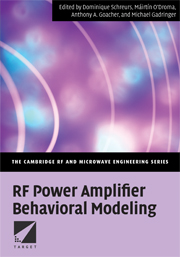Book contents
- Frontmatter
- Contents
- Notation
- Abbreviations
- Preface
- 1 Overview of power amplifier modelling
- 2 Properties of behavioural models
- 3 Memoryless nonlinear models
- 4 Nonlinear models with linear memory
- 5 Nonlinear models with nonlinear memory
- 6 Validation and comparison of PA models
- 7 Aspects of system simulation
- Appendix A Recent wireless standards
- Appendix B Authors and contributors
- Index
6 - Validation and comparison of PA models
Published online by Cambridge University Press: 06 January 2010
- Frontmatter
- Contents
- Notation
- Abbreviations
- Preface
- 1 Overview of power amplifier modelling
- 2 Properties of behavioural models
- 3 Memoryless nonlinear models
- 4 Nonlinear models with linear memory
- 5 Nonlinear models with nonlinear memory
- 6 Validation and comparison of PA models
- 7 Aspects of system simulation
- Appendix A Recent wireless standards
- Appendix B Authors and contributors
- Index
Summary
Introduction
This chapter deals with PA model validation and comparison. In general PAs are complex dynamic systems that combine both short- and long-term memory effects with nonlinear phenomena. In contrast with linear systems with memory, where superposition holds and so any test signal can be used, or nonlinear systems with linear memory, where memory effects can be separately characterised and de-embedded to obtain a simple algebraic descriptive function, nonlinear dynamical systems must be ‘locally’ modelled and validated. Therefore, test signals and model comparison criteria must be carefully chosen to suit a particular set of typical operating conditions.
This chapter proposes suitable figures and characteristics of merit (i.e. metrics) that enable the performance of different PA models for telecommunication applications to be compared. It is divided into two parts.
In the first part, general figures of merit (FOMs) are presented and the main concepts regarding their applicability are explained. Although most of the proposed metrics can be generalised for sampled and/or stochastic signals, only deterministic continuous-time signals are considered here. Starting from a general time-domain metric, several variants are proposed, each specially suitable for a certain measurement setup.
The second part of the chapter deals with more realistic applications, in that most of the proposed FOMs are formulated for sampled (i.e. discrete-time) signals and are in terms of statistical measures such as the covariance and the power spectral density (PSD). The stochastic-process point of view may be useful for modern measurement instruments and system simulators, where complex telecommunication standards test signals are usually characterised statistically.
- Type
- Chapter
- Information
- RF Power Amplifier Behavioral Modeling , pp. 215 - 232Publisher: Cambridge University PressPrint publication year: 2008

